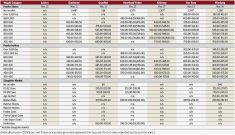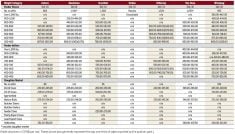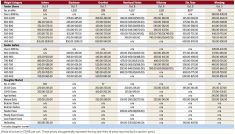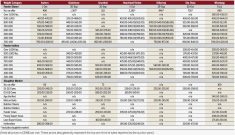You might have read in our paper last week about the amount of food wasted in Canada every year.
The numbers are eye popping. We are throwing away a mountain of food – about 40 per cent of all food produced in this country.
That’s about $27 billion worth of edibles, or slightly less than what the value of Canada’s agricultural and agri-food exports were worth in 2007.
Half of all that waste is lost within the supply chain as food heads from the field to our tables. The other half is lost as a result of our own day-by-day habits of buying, not consuming and then tossing out food.
Read Also
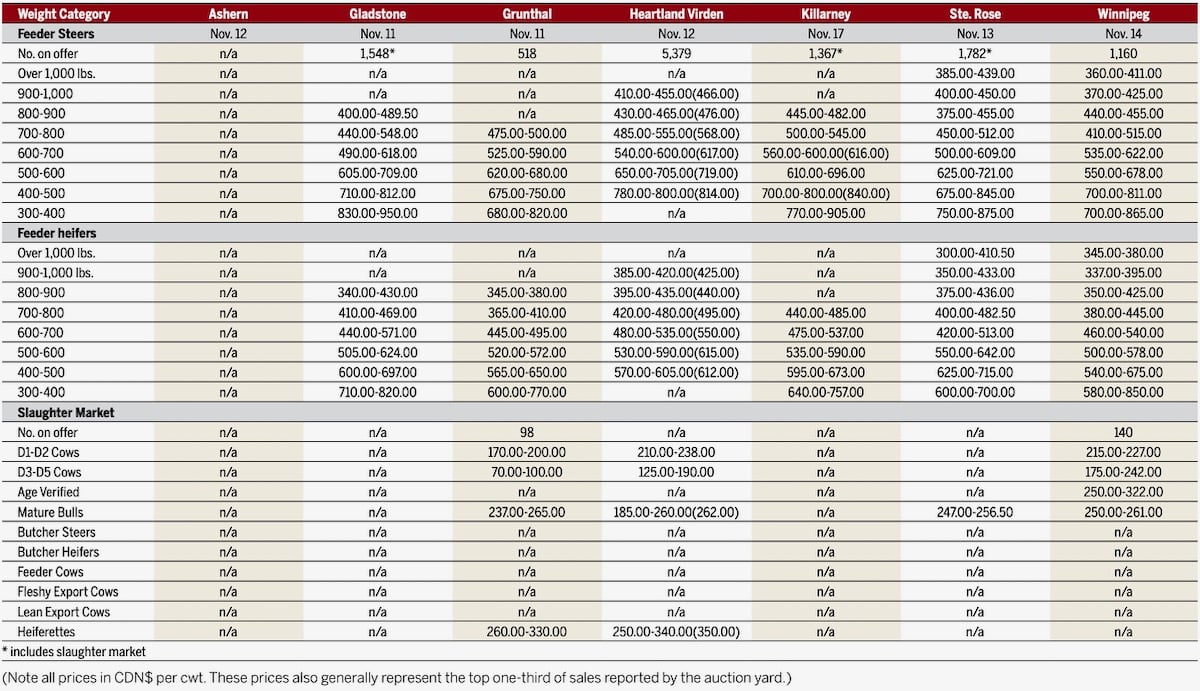
Manitoba cattle prices, Nov. 17
In other words, this is a firmly entrenched habituation of our culture to utterly devalue food.
The George Morris Centre’sFood Waste in Canadareport should stir us to stop and think hard about our reckless consumption habits.
This is a volume of food whose dollar value is higher than the combined Gross Domestic Product (GDP) of the 32 poorest countries in the world. What would those in countries with bare cupboards -and those in our own who lack enough to eat -think to hear this?
TheFood Waste in Canadareport’s main point is that agriculture and the food industries should start taking new approaches through value chain production, taking the emphasis off volume and price in order to bring down food waste.
But change has to start at home too, if we’re to stop recklessly squandering food, and all the other precious resources of water, energy and human effort being wasted along with it.
After reading the report last week, I started to think about simple ways to start curbing food-wasting habits.
I expect many of you do not take food for granted, and are skilled and conscientious with regard to careful food preparation, portioning and storage. On the right are a few ideas to pass on to those you think could use a little help.
This seems like a week for a few leftover recipe ideas too, so enjoy the two recipes from the Beef Information Centre’s “Lovin’ Leftovers” section on its website ( www.beefinfo.org).
RUSTIC ITALIAN BEEF AND TOMATO SOUP
This simple beef-based meal-soup recipe has two unlikely ingredients: tomato juice and day-old bread. The bread is an old-fashioned no-fat trick for thickening. A half-cup of tomato juice represents one Food Guide serving of vegetables.
2 tbsp. olive oil
1 onion, chopped
2 carrots, sliced into
half-rounds
4 cloves garlic, minced
1/2 tsp. (2 ml) dried
rosemary, crumbled
1/4 tsp. (1 ml) each salt
and pepper
3 c. tomato juice
1 c. sodium-reduced
beef broth
2 c. slivers of thinly sliced
cooked roast beef or
cooked extra-lean
ground beef
(see Cook’s Notes below)
3 c. large cubes day-old
baguette, French stick or
ciabatta bread
1/4 c. Parmigiano-
Reggiano or Romano
cheese, grated
1/4 c. fresh basil or
parsley, minced
Heat oil over medium-high heat in large saucepan; cook onion, carrots, garlic, rosemary, salt and pepper, stirring occasionally, until softened, about 8 minutes. Add tomato juice, beef broth and 1 cup water; bring to boil. Reduce heat and simmer for 10 minutes. Add beef and bread; stir until bread has “melted” into soup and soup thickens, about 8 minutes. Stir in cheese and basil.
Cook’sNotes:Toget 2 cups cooked ground beef, cook 1 lb. extra-lean or lean ground beef sirloin or ground beef in non-stick skillet, over medium-high heat for 8 to 10 minutes, breaking into small chunks with back of spoon while cooking. Cook until browned and completely cooked. Drain.
THAI BEEF WRAPS
These easy-to-make wraps use up leftover roast beef and could also make a great take-to-the-party food this time of year.
8 oz. shaved cooked
roast beef (or deli
roast beef)
1 c. Thai-style sweet
chili sauce
1 small carrot, finely
shredded
2 each sweet red
peppers and green
onions, finely diced
1/4 c. fresh basil, finely
chopped
2 tbsp. fresh cilantro,
finely chopped
8 plain or flavoured
8-inch tortillas
Place cooked beef in sealable bag. Add 1/4 cup of the Asian sauce; marinate for 10 minutes. Combine carrot, red peppers, onions, basil, cilantro and 1/4 cup of the Asian sauce in small bowl. Add beef mixture; mix well. Divide beef mixture evenly among tortillas. For each wrap, fold in both ends and roll up. Cut each wrap in half (secure with toothpicks, if necessary). Serve immediately with remaining sauce for dipping.
Sendyourrecipesorreciperequeststo:
ManitobaCo-operatorRecipeSwap
Box 1794, Carman, Man. R0G 0J0
or email [email protected]
———
Recipe Swap
orManitobaWeBoxemail enjoy love [email protected]
1794Please receiving hearing recipeCo-operatorCarman,contact requests. from yourMan.us readers recipesRecipeat:R0GandSwapor0J0
———
Keep a food diary
Some of us jot down how much food we consume as a trick to lose weight. Keep a food waste diary to figure out what you tend to throw away. Then use the insight to change shopping and storage habits.
Freeze or dry leftover bread
Instead of tossing the last few slices when the new loaf arrives, leave them out to dry and crush them or put through a food processor for bread-crumbs. Many people freeze extra loaves of bread too.
Pay attention to portion control when cooking
That extra cup thrown in the pot may end up tossed. Think about who eats at your table and whether there tends to be leftovers on plates headed to the garbage after dinner.
When in doubt throw it out, but…
Why not freeze cooked leftovers immediately? That’s better than leaving them in the back of the fridge until they’re unusable. Dividing up leftovers to freeze is a simply way to have quick meals when you don’t feel like cooking later on.
Make soup
Many families have a perpetual pot of soup on the stove. It’s the perfect way to quickly use up all sorts of leftover veggies and meats, and even chunks of bread (see recipe on this page).
Cool, dark places
Pay attention to where things are kept in stores, then store them appropriately at home. Bananas don’t need to be refrigerated. Potatoes like cool, dark places.
Why wilt?
I’m guilty of tossing what was a nice bunch of purchased parsley or other fresh herbs (bought during winter occasionally). Keeping them in a jar of water in the fridge keeps them fresh much longer. Or freeze them into cubes like you do preserving garden grown. Seasoning above-mentioned soup a snap with them.
Bad apples
Eatthat fresh fruit you bought! Don’t let it go mouldy. Canadians seldom consume the recommended daily amount of vegetables and fruit. Don’t buy seven ripe anything if you only eat one a day. (And learn to make banana bread. The browner the banana, the richer the flavour).
Best before
The “best-before” date is not an indicator of food safety, either before or after the product is opened. You can buy and eat foods after the “best-before” date has passed. It’s just that the food may have lost some of its quality, including nutritional value, as a product ages past that date. Best-before dates apply to unopened products only.



